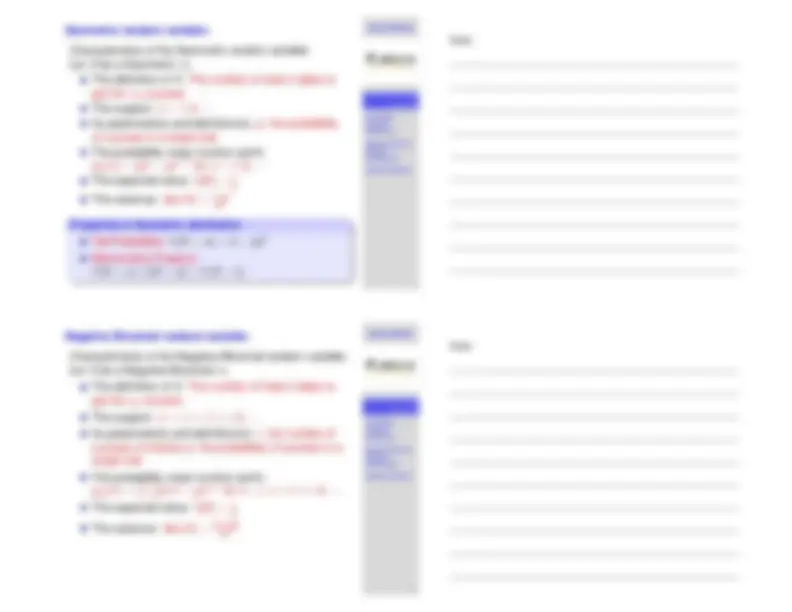





Study with the several resources on Docsity

Earn points by helping other students or get them with a premium plan


Prepare for your exams
Study with the several resources on Docsity

Earn points to download
Earn points by helping other students or get them with a premium plan
Community
Ask the community for help and clear up your study doubts
Discover the best universities in your country according to Docsity users
Free resources
Download our free guides on studying techniques, anxiety management strategies, and thesis advice from Docsity tutors
STAT 225 Introduction to Probability Models. March 5, 2014. Whitney Huang. Purdue University. Exam 2 Review. Discrete Random. Variables. Choosing a.
Typology: Study notes
1 / 6

This page cannot be seen from the preview
Don't miss anything!




Discrete Random Variables Choosing a Discrete Distribution Approximation for Discrete Distributions Nested Problems
.
STAT 225 Introduction to Probability Models March 5, 2014
Whitney Huang Purdue University
Exam 2 Review
Discrete Random Variables Choosing a Discrete Distribution Approximation for Discrete Distributions Nested Problems
Agenda
(^1) Discrete Random Variables
(^2) Choosing a Discrete Distribution
(^3) Approximation for Discrete Distributions
(^4) Nested Problems
Notes
Notes
Discrete Random Variables Choosing a Discrete Distribution Approximation for Discrete Distributions Nested Problems
.
Bernoulli random variable
Characteristics of the Bernoulli random variable: Let X be a Bernoulli r.v. The definition of X : It is the number of success in a single trial of a random experiment The support (possible values for X ): 0: “failure" or 1: “success" Its parameter(s) and definition(s): p: the probability of success on 1 trial The probability mass function (pmf): pX (x) = px^ ( 1 − p)^1 −x^ , x = 0 , 1 The expected value: E [X ] = p The variance: Var (X ) = p( 1 − p)
Exam 2 Review
Discrete Random Variables Choosing a Discrete Distribution Approximation for Discrete Distributions Nested Problems
Binomial random variable
Characteristics of the Binomial random variable: Let X be a Binomial r.v. The definition of X : It is the number of successes in n trials of a random experiment, where sampling is done with replacement (or trials are independent) The support: 0, 1 , · · · , n Its parameter(s) and definition(s): p: the probability of success on 1 trial and n is the sample size The probability mass function (pmf): pX (x) =
(n x
px^ ( 1 − p)n−x^ , x = 0 , 1 , · · · , n The expected value: E [X ] = np The variance: Var (X ) = np( 1 − p)
Notes
Notes
Discrete Random Variables Choosing a Discrete Distribution Approximation for Discrete Distributions Nested Problems
.
Geometric random variable:
Characteristics of the Geometric random variable: Let X be a Geometric r.v. The definition of X : The number of trials it takes to get the 1st success The support: x = 1 , 2 , · · · Its parameter(s) and definition(s): p: the probability of success in a single trial The probability mass function (pmf): pX (x) = p( 1 − p)x−^1 for x = 1 , 2 , · · · The expected value: E [X ] = (^1) p The variance: Var (X ) = (^1) p− 2 p
Properties of Geometric distribution Tail Probability: P (X > x) = ( 1 − p)x Memoryless Property: P (X > s + t|X > s) = P (X > t)
Exam 2 Review
Discrete Random Variables Choosing a Discrete Distribution Approximation for Discrete Distributions Nested Problems
Negative Binomial random variable:
Characteristics of the Negative Binomial random variable: Let X be a Negative Binomial r.v. The definition of X : The number of trials it takes to get the rst success The support: x = r , r + 1 , r + 2 , · · · Its parameter(s) and definition(s): r : the number of success of interest p: the probability of success in a single trial The probability mass function (pmf): pX (x) =
(x− 1 r − 1
pr^ ( 1 − p)x−r^ for x = r , r + 1 , r + 2 , · · · The expected value: E [X ] = rp The variance: Var (X ) = r^ (^1 p− 2 p)
Notes
Notes
Discrete Random Variables Choosing a Discrete Distribution Approximation for Discrete Distributions Nested Problems
.
Choosing a Discrete Distribution
Exam 2 Review
Discrete Random Variables Choosing a Discrete Distribution Approximation for Discrete Distributions Nested Problems
Approximation for Discrete Distributions
Binomial approximation for Hypergeometric
If X ∼ Hyp(N, n, K ) and N is sufficiently larger than n, say N > 20 n, then we can approximate the distribution X by using X ∗^ ∼ Bin(n, p), where p = KN
Poisson approximation to Binomial
If X ∼ Binomial(n, p) with n > 100 and p < .01 then we can approximate the distribution X by using X ∗^ ∼ Poisson(λ = n × p)
Notes
Notes